Do you need a smart speaker? No. Should you get one? Totally. Smart speakers are to speakers what smart phones are to phones; a technology that turns a simple, utilitarian device into something that can do so much more. After a slow start, smart speakers are becoming increasingly popular.
What makes a smart speaker smart is its Wi-Fi connection and built-in voice assistant. Microphones sit alongside the speaker to listen for your commands that will activate the assistant and send your request to the cloud. There it’s analysed and a (hopefully) appropriate response is sent back in seconds to help you with everyday tasks such as playing music, checking your calendar, or making a phone call.
With a smart speaker you can accomplish things entirely handsfree just by speaking a few words. Look up the opening hours for a museum while you’re packing lunch, set a timer for your boiled egg, or add more eggs to your shopping list. Some also have screens attached to their speakers, to give you visual feedback, as well as another place to watch Netflix.
We love cool gadgets, so we tested 15 smart speakers, featuring the three most popular voice assistants – Google’s Assistant, Amazon’s Alexa and Apple’s Siri - and our top pick is the Sonos One. A versatile, good-looking speaker with great sound, it’s the only one we tested that works with all three ecosystems. But there are many shapes, flavours, and form factors for smart speakers, so read on to find which is the best smart speaker for you.
Best smart speakers in 2024 reviewed
Best smart speaker
Price: £199.99 | Assistant: Alexa, Google Assistant | Colours: Black, White | Speakers: Two Class-D digital amplifiers, one tweeter and one mid-woofer | Size: 161.45 x 119.7 x 119.7 mm, 1.85kg
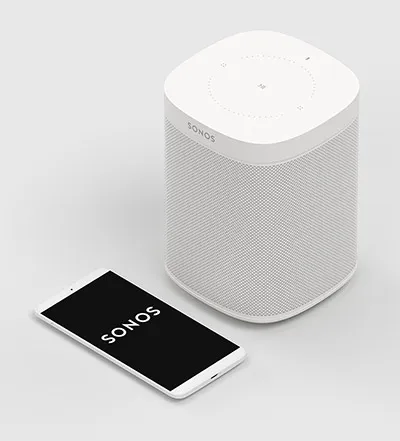
This little speaker packs a lot of punch, two voice assistants, and hooks into Sonos’s wider world of wireless music, making it the most versatile speaker we tested. It also works with Apple’s AirPlay system (letting you can play music directly from your Apple devices) and while it’s not a Bluetooth speaker it covers pretty much every other avenue you might want to stream your music through.
The Sonos One works incredibly well as a smart voice assistant, especially considering it’s not made by Amazon or Google. This is a big reason it’s our top choice; you’re not locked in to one ecosystem as you are with most other smart speakers, you can switch between Alexa and Google at will. If you’re just dipping your toe in the smart speaker waters, this is the perfect way to test them out without committing.
The Sonos One responded appropriately to our commands, as speedily as any of the Alexa or Google devices we tested, turning on our connected lights in the same amount of time and streaming our “dinnertime” playlist from Spotify in seconds. It also has a more appealing design than any of the native offerings, looking more at home on our living room side table.
Its app is a bit fiddly and had some connectivity issues in our testing – but with voice control added you don’t need to mess with it much, just say the word. Also, Sonos won’t let you pair its speakers with non-Sonos speakers to take advantage of Amazon or Google’s multi-room audio – a symptom of not committing unfortunately.
But you can group all your Sonos device together in Amazon’s Alexa app. This lets you add them to Alexa Routines and do fun stuff like have music start playing when you arrive home, or put on a soothing playlist when bedtime rolls around.
2
Echo Dot (third generation)
Best smart speaker on a budget
Price: £39.99 | Assistant: Alexa | Colours: Black, Grey, Pink, White | Speakers: 1.6" speaker, 3.5 mm audio line out | Size: 43 x 99 x 99 mm, 300g

If sound quality isn’t top priority (or you have a nice home audio set up already), the Echo Dot is the best place to start your smart speaker journey. The cheapest real speaker in the Echo line (which includes the largest variety of smart speakers of any manufacturer) the Echo Dot houses Alexa, Amazon’s voice assistant, and produces a decent amount of sound for listening to the radio, a podcast or audio book, or some tunes (in a pinch).
Crucially, it has an audio out option, so you can connect it to superior speakers with a simple audio cable and get the smart speaker benefit for less, a feature Google’s similar model the Nest Mini doesn’t offer. It also works as a Bluetooth speaker.
The biggest benefits of the Dot are it’s small, cheap, sounds fine, and can do everything any of the bigger Alexa’s can. If you want to do the whole home audio thing for less and have voice control of your smart home in every room, the Dot will do the job without breaking the bank.
Amazon just announced the Echo Dot fourth generation, but other than a few small tweaks and a new spherical look, it’s basically the same device. This is good news, as given Amazon’s penchant for sales, you should be able to scoop up a third-gen Dot for a steal.
3
Echo Studio
Best sounding smart speaker
Price: £189.99 | Assistant: Alexa | Colours: Black | Speakers: 25mm tweeter, three 51 mm mid-range speakers, and 133 mm woofer, 3.5 mm/mini-optic line in, Dolby Atmos | Size: 43 x 99 x 99 mm, 3.5kg

Amazon’s Echo Studio is an imposing, heavy black speaker - you won’t miss this on the coffee table. But if you want good sound and a genuinely smart, smart speaker, it is the best on offer at a jaw-droppingly good price. Most speakers this size and quality start a couple hundred quid higher and don’t have anywhere near its smarts.
The Studio packs a lot of high-end audio into that big frame, delivering superb, 360 sound from its – count them – five speakers. Plus, it can do fancy things like sense the acoustics of your room for optimal playback and play 3D audio to make it sound like the drums are behind you and the singer is in front. We were particularly impressed at how well Alexa responded on the Studio, even when we had the speaker cranked to its impressively loud top volume.
What makes it really stand out as a smart home speaker is the built in Zigbee radio, which turns it into a smart home hub that you can easily add devices like Philips Hue smart light bulbs, SmartThings motion sensors, and Amazon smart plugs to – without needing any other hubs or devices to control them. Just plug them in, turn them on and your Echo Studio will automatically add them to your Alexa app. From here you can create fun and useful Routines, such as when motion is detected after dark turn on my lights and start the kettle.
4
Nest Hub Max
Best smart speaker with a screen
Price: £219.99 | Assistant: Google | Colours: White, Black | Speakers: Two 18mm tweeters, a 75mm bass driver | Size: 182.55 x 250.1 x 101.23 mm, 1.32 kg

The Nest Hub Max is our favourite smart display (smart speaker with a screen) because it can recognise who is using it and serve up personalised information (my calendar appointments for the day, not my husband’s) without you even having to say a word – taking the smart speaker to the next level.
It also combines a good sounding stereo speaker that contains all the capabilities of Google’s smart assistant with a gorgeous touch screen that you can use to watch Netflix, flip through YouTube, or follow along with recipes while you’re cooking. The video chat feature can even pan and zoom the built-in camera to keep you in the frame while you’re on a call – helpful if you’re like us and multitask while talking.
When it’s not in use, the screen can double as a digital photo frame, automatically pulling photos from your Google Account and intelligently selecting the best ones (so you don’t get random screenshots) – using an ambient light sensor that automatically adjust the brightness making photos look like real printed photos, not glossy digital images.
On the talking less front, it also works with hand gestures – raise one to stop the music or video playing and raise it again to resume. As much as we enjoy talking to our smart speakers, there are times when it just isn’t appropriate, and the Nest Hub Max has you covered. From hand gestures to a touch screen interface that lets you control smart home devices like lights, locks or thermostats, the Nest Hub Max offers the best of both home control world – voice and touch.
5
Nest Audio
Best smart speaker for Google Assistant
Price: £89.99 | Assistant: Google | Colours: White, Black | Speakers: 75 mm woofer and 19 mm tweeter | Size: 175 x 124 x 78 mm, 1.2 kg
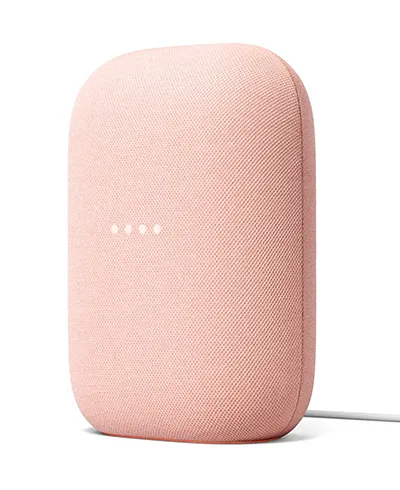
If Google Assistant is your artificial intelligence of choice, Google’s newest smart speaker Nest Audio is your best bet. With an ideal combination of good value, great sound, and super smarts, Nest Audio is an excellent pick for a Google-powered smart speaker.
We really like the super minimalist design of this slim, rectangular speaker, which doesn’t look like a smart speaker at all – no glowing LED rings here, just 4 four subtle LED dots that show through the mesh fabric (all post-consumer recycled content), when you call its name. Three touch-capacitive buttons are hidden under the mesh too, for volume and pausing playback, and the only physical button is the mute switch on the back.
Compared to its giant big brother, Google Home Max, Nest Audio strikes a good balance between a form that will fit most anywhere (it has an impressively tiny footprint) and a top-quality audio performance. Pair two in stereo and you can easily fill a room with pumping sound when needed. Plus, it adapts to the space it’s in as well as to what it’s playing, tuning the sounds specifically to your podcast versus your Spotify playlist.
In our sound testing, the Nest Audio delivered clear, crisp vocals, and while there was a tiny bit of vibration at top volume on the bigger bass notes, the lows and mids were strong and balanced. It also responded very well to voice commands, even when the music was blasting, and we love the option to move the music to another speaker just with your voice, so you can continue your tunes seamlessly when you switch rooms. However, Google Assistant’s tendency for long-winded replies – even to simple requests – is really irritating.
Thankfully, the Assistant’s wordiness doesn’t hamper its ability to control your smart home devices, which it does with ease. And while the scope and range of compatible products isn’t as large as those that work with its main rival, Alexa, there are more than enough light bulbs, plugs, cameras, and security systems to choose from, and we find the Google Home app much easier to use for managing your home’s devices than Alexa’s clunky app.
6
Echo (4th generation)
Best smart speaker for Alexa
Price: £89.99 | Assistant: Alexa | Colours: White, Black, Blue | Speakers: 3.0” woofer and dual 0.8" tweeters | Size: 144 x 144 x 133 mm, 970 g
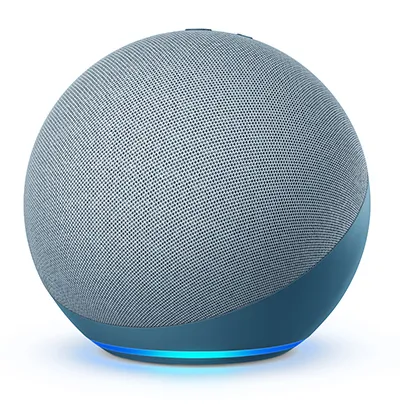
The all new Echo smart speaker is a very impressive entry into what you can tell by now is a very crowded space. The fourth generation of the device that started it all, the new Echo comes with a completely new look, enhanced sound performance, and much better brains.
Now shaped like a ball instead of the previous design of a tall cylinder, the Echo speaker contains dual firing tweeters to provide stereo sound from just one device – a first at this price point (and you can still put two together for a stronger sounding stereo pair). The shape helps enhance the sound projection and the device can sense the acoustics of the space, delivering clear, clean sound that projects superbly, filling a room easily.
Alongside an appearance upgrade, the internals have been significantly enhanced, with a new processor that promises the built-in voice assistant Alexa will respond to requests faster and learn what you need more quickly. Unfortunately, while it’s in there the processor’s powers aren’t activated yet, so we weren’t able to test this out. We were able to play with the new Zigbee radio however, which turns the Echo into a bona fide smart home hub, meaning you can now connect a much wider range of smart home devices directly to it.
It’s also so easy – no need to plug extra bridges or dongles into your router, just choose compatible smart devices like plugs, light bulbs, and even door locks, turn them on and your Echo will see them and add them to your Alexa app. Now you can control them with your voice and string them together with other gadgets into smart home routines. We love this new upgrade, as it makes the whole process of bringing smart devices into your home much less complicated and much less expensive (the closer to £200 Studio and Echo Show are the only other Alexa devices with a smart hub built-in).
The Alexa smart home platform is easily the largest in terms of compatibility and its Routines offer a lot more customisation than Google’s offerings. The biggest difference being that Alexa can recognise devices like motion sensors and contact sensors (many of which use that Zigbee radio which Google’s speakers don’t have) so you could potentially take your voice out of the whole smart home process. Instead of having to say Alexa lights on, it could just turn them on for you walk in. That’s smart.
7
Apple HomePod
Best smart speaker for Siri
Price: £279.99 | Assistant: Siri | Colours: White, Black | Speakers: 7 tweeters, 4 woofers | Size: 172 x 142 mm, 2.5 kg
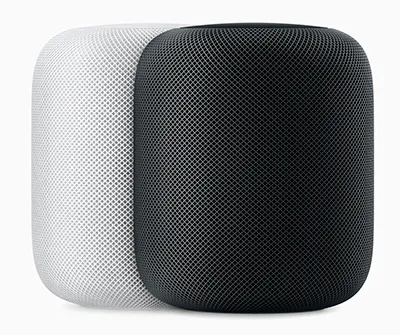
A beautifully designed, impressively high-quality speaker – easily on par with the Sonos 1 sound-wise, even slightly better – this speaker punches well above its weight (which is surprisingly light for a speaker this powerful). It doesn’t quite beat the Echo Studio, but it’s close, and more than half the size so much easier to find a suitable spot for in your living room.
Serious sounds aside, the primary reason to purchase the HomePod is it’s the only smart speaker with Apple’s Siri built in. If you are an iPhone user, have Apple computers, and maybe even an Apple Watch or Apple TV, this is the same Siri you know and sort of love, and it will fit seamlessly into your home set up.
The HomePod also acts as a hub and remote control for Apple’s HomeKit, a smart home ecosystem that lets you connect and control everything from your lights and thermostats to your shades and security cameras and use voice commands through Siri. While Siri lacks somewhat in the smarts department compared to Google or Alexa, it’s much snappier as a smart home manager, turning off lights in a flash or triggering Scenes in seconds. Of course, it can also add things to your shopping list, set timers, and get you the news and weather, as well as make phone calls and send text messages.
Back to that sound though, it’s not just good it’s also smart. The HomePod features room adaptive sound that can go from 360 audio when situated smack in the middle of one, to pushing the primary sections of the song out into the room and the secondary ones back to the walls for better dispersion when positioned against a wall.
Uniquely, you can also pair it with a pretty wide range of speakers and soundbars form other manufacturers to get wireless music throughout you home, thanks to Apple’s AirPlay 2 tech. This even includes big names like Sonos and Bose, both of which opted out of multi-room music on Google and Alexa’s platforms.
The biggest drawback to the HomePod is that price, it’s way more expensive than almost everything on our list. But the good news is the HomePod Mini is coming next month (NOV), for just £89. You won’t get the seriously impressive sound chops, but all the other features will be there – and some new ones too – including an intercom capability that can send a message to every Apple device you or your family owns – including headphones. That means your teenager can never say they didn’t hear you call them for dinner again.
8
Bose Portable Smart Speaker
Best portable smart speaker
Price: £329.99 | Assistant: Google or Alexa | Colours: Silver, Black | Speakers: | Size: 10.4 x 11.9 x 19.15 cm, 1.06 kg
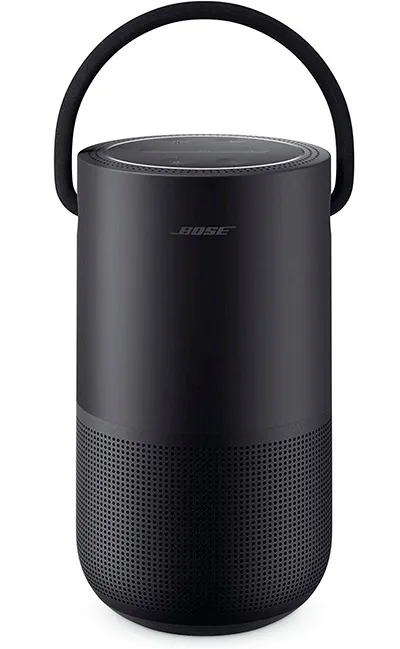
While you pay quite the premium for it, this powerful little speaker is totally portable. Meaning you can have all the handsfree capabilities of a smart speaker without worrying about wires. Play tunes in the garden with just a word, bring it to the park for pop quizzes, or just easily move your smart assistant from room to room in your house, so it’s always with you. As long as there is Wi-Fi you can call on Alexa or Google (it works with both, but not at the same time) to respond to your every command.
Whether you need a portable voice-controlled speaker is totally a personal choice. Consider how important the extra capabilities of a voice assistant are where you want to use this, and if you’ll have Wi-Fi there (without Wi-Fi it’s just a Bluetooth speaker), or if a simple, much less expensive Bluetooth speaker will do.
If you do need this feature, however, you can’t go wrong with this speaker. It has an impressive 12-hour battery life and is water resistant, plus has a nifty, durable carrying handle, which its closest competitor – the Sonos Move – doesn’t. It’s also significantly lighter than the Move, which weighs in at a hefty 3 kg, although we wouldn’t describe either one as particularly robust.
Sound-wise this speaker easily meets (and in some cases beats) every model in our roundup – only bested by the Echo Studio in terms of loudness and bass. It’s a really impressive noisemaker, as you would expect from a company with Bose’s audio chops. It’s also beautifully designed, with a sturdy aluminum grid casing, clean and easy to use control pad, and substantial woven carrying handle.
You can pair it with any existing Bose speakers for multi-room music, but – as with Sonos – it won’t pair with any Amazon or Google speakers, it does work with Apple’s AirPlay2.
How we tested the smart speakers
A journalist for over two decades, I write about smart home devices for The New York Times’ Wirecutter, Wired, U.S. News & World Report, Dwell magazine, and The Ambient. I’ve been testing smart speakers for 6 years and for this article put each model through the same series of tests to evaluate its audio quality and listening responsiveness.
This included sending commands from different distances, at different volumes (both of our voice, of music playing, and of background noise), as well as asking the same questions and giving the same commands to all three virtual assistants to determine which performed the quickest and most appropriately.
What do I need to know before I buy a smart speaker?
Bluetooth speaker or smart speaker?
A Bluetooth speaker mirrors the sound coming for your computer or phone – that’s every sound, including when someone calls your phone or the ding when you get a new email. This can ruin the mood if you’re chilling with some tunes. A smart speaker connects to the internet using Wi-Fi and streams music directly – from a service such as Spotify or Apple Music – no interruptions necessary.
Most of the time a smart speaker can also work as a Bluetooth speaker, but the best feature of smart speakers is they work with each other, wirelessly. That means multi-room audio without the headache of running wires through your ceiling. Simply pair two, three, four or more compatible speakers together and use your voice to play the same song throughout your house. It’s like magic, only cheaper.
Pick your artificial intelligence
All smart speakers come with virtual assistants on board, Alexa and Google Assistant are the top two, with Siri coming a distant third (the Apple HomePod is the only speaker that works with it.) They all use artificial intelligence to recognise and respond to your voice commands.
Which is best depends on what you’ll be using it for. Alexa is great with Amazon Music, Prime Video, Ring smart home devices, Audible audiobooks, and for buying stuff off Amazon. Google plays best with YouTube Music, YouTube videos, Google Play books and movies, and Google Nest smart home devices (like the Nest Thermostat).
Siri works seamlessly with all Apple products and services, as well as any Apple HomeKit smart home devices. Most other popular, platform agnostic streaming services and smart home devices work with all three (such as Spotify, TuneIn, BBC Radio, Netflix, Philips Hue smart lights, Arlo security cameras etc.).
Smart speakers can make your home smarter
Speaking of smart home devices, adding a smart speaker to your home makes controlling any home automation gadgets you have much easier. Again, no need to get out your phone to turn your lights on, just ask and you shall receive. A smart speaker with a screen also lets you quickly view footage from any connected security cameras you might have and see who’s at your front door if you have a video doorbell.
Smart speakers also enable what are called smart home Routines by Amazon and Google (and Automations by Apple). These are easy to set up programs where you can daisy chain devices together in your virtual assistant’s app on your smartphone and then activate them just by giving your speaker the command. For example, tell your Google smart speaker “It’s bedtime” and have your connected lights turn off, your smart door locks lock, and your thermostat turn down.
Other features on offer include using your speakers as an intercom system between different rooms in your house (“Hey Google, broadcast to the living room that dinner is ready”), to control your television with your voice if you have a compatible smart TV (“Alexa, play Tiger King from Netflix on my Living Room FireTV”), or to make and receive phone calls (even video calls if you have a smart display – Zoom is coming to Google and Amazon smart displays very soon).
Are smart speakers always listening?
Yes. When plugged in and turned on a smart speaker is always listening… for its wake word. Be it “Ok Google” or “Alexa” or “Computer” for Amazon Echo speakers, or “Hey Siri” for Apple gadgets, the artificial intelligence in your device is constantly scanning audio for that word, and when it hears it, will start recording. All smart speakers have a mute button and can be easily unplugged – which might be worth doing during any sensitive conversations.
The security in these devices is excellent, and it’s just as difficult for a “hacker” to tap into the microphone on your smart speaker as it is to get into your smartphone. But if you don’t like the idea that Amazon and Google are processing and harvesting data about you through these devices, you can tell your speaker to delete voice recordings and manage what they know about you on your Google devicesand your Amazon devices. Apple, on the other hand, does not tie Siri voice recordings to your account.
Read more buyer's guides: